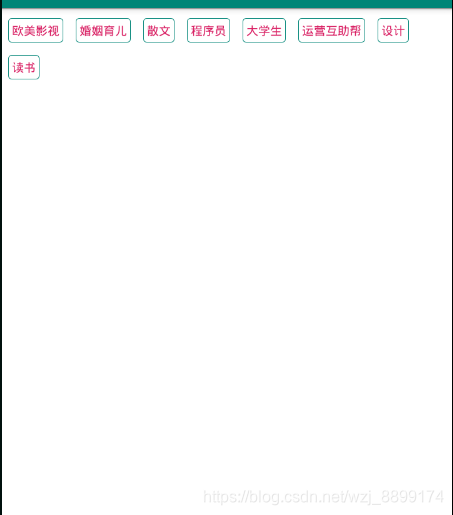实现效果:
一.布局文件
<comp.bwei.flowlayout.FlowLayout
android:layout_width="match_parent"
android:layout_height="wrap_content"
android:layout_marginTop="5dp">
<TextView
android:layout_width="wrap_content"
android:layout_height="wrap_content"
android:layout_margin="8dp"
android:background="@drawable/shape_tv_blue"
android:padding="5dp"
android:text="欧美影视"
android:textColor="@color/colorAccent" />
<TextView
android:layout_width="wrap_content"
android:layout_height="wrap_content"
android:layout_margin="8dp"
android:background="@drawable/shape_tv_blue"
android:padding="5dp"
android:text="婚姻育儿"
android:textColor="@color/colorAccent" />
<TextView
android:layout_width="wrap_content"
android:layout_height="wrap_content"
android:layout_margin="8dp"
android:background="@drawable/shape_tv_blue"
android:padding="5dp"
android:text="散文"
android:textColor="@color/colorAccent" />
<TextView
android:layout_width="wrap_content"
android:layout_height="wrap_content"
android:layout_margin="8dp"
android:background="@drawable/shape_tv_blue"
android:padding="5dp"
android:text="程序员"
android:textColor="@color/colorAccent" />
<TextView
android:layout_width="wrap_content"
android:layout_height="wrap_content"
android:layout_margin="8dp"
android:background="@drawable/shape_tv_blue"
android:padding="5dp"
android:text="大学生"
android:textColor="@color/colorAccent" />
<TextView
android:layout_width="wrap_content"
android:layout_height="wrap_content"
android:layout_margin="8dp"
android:background="@drawable/shape_tv_blue"
android:padding="5dp"
android:text="运营互助帮"
android:textColor="@color/colorAccent" />
<TextView
android:layout_width="wrap_content"
android:layout_height="wrap_content"
android:layout_margin="8dp"
android:background="@drawable/shape_tv_blue"
android:padding="5dp"
android:text="设计"
android:textColor="@color/colorAccent" />
<TextView
android:layout_width="wrap_content"
android:layout_height="wrap_content"
android:layout_margin="8dp"
android:background="@drawable/shape_tv_blue"
android:padding="5dp"
android:text="读书"
android:textColor="@color/colorAccent" />
</comp.bwei.flowlayout.FlowLayout>
二.自定义类
public class FlowLayout extends ViewGroup {
public FlowLayout(Context context) {
this(context, null);
}
public FlowLayout(Context context, AttributeSet attrs) {
this(context, attrs, 0);
}
public FlowLayout(Context context, AttributeSet attrs, int defStyleAttr) {
super(context, attrs, defStyleAttr);
}
private List<List<View>> mLineViews = new ArrayList<List<View>>();
private List<Integer> mLineHeight = new ArrayList<Integer>();
/**
* 测量所有子View大小,确定ViewGroup的宽高
*
* @param widthMeasureSpec
* @param heightMeasureSpec
*/
@Override
protected void onMeasure(int widthMeasureSpec, int heightMeasureSpec) {
super.onMeasure(widthMeasureSpec, heightMeasureSpec);
//由于onMeasure会执行多次,避免重复的计算控件个数和高度,这里需要进行清空操作
mLineViews.clear();
mLineHeight.clear();
//获取测量的模式和尺寸大小
int widthMode = MeasureSpec.getMode(widthMeasureSpec);
int widthSize = MeasureSpec.getSize(widthMeasureSpec) - getPaddingLeft() - getPaddingRight();
int heightMode = MeasureSpec.getMode(heightMeasureSpec);
int heightSize = MeasureSpec.getSize(heightMeasureSpec) + getPaddingTop() + getPaddingBottom();
//记录ViewGroup真实的测量宽高
int viewGroupWidth = 0 - getPaddingLeft() - getPaddingRight();
int viewGroupHeight = getPaddingTop() + getPaddingBottom();
if (widthMode == MeasureSpec.EXACTLY && heightMode == MeasureSpec.EXACTLY) {
viewGroupWidth = widthSize;
viewGroupHeight = heightSize;
} else {
//当前所占的宽高
int currentLineWidth = 0;
int currentLineHeight = 0;
//用来存储每一行上的子View
List<View> lineView = new ArrayList<View>();
int childViewsCount = getChildCount();
for (int i = 0; i < childViewsCount; i++) {
View childView = getChildAt(i);
//对子View进行测量
measureChild(childView, widthMeasureSpec, heightMeasureSpec);
MarginLayoutParams marginLayoutParams = (MarginLayoutParams) childView.getLayoutParams();
int childViewWidth = childView.getMeasuredWidth() + marginLayoutParams.leftMargin + marginLayoutParams.rightMargin;
int childViewHeight = childView.getMeasuredHeight() + marginLayoutParams.topMargin + marginLayoutParams.bottomMargin;
if (currentLineWidth + childViewWidth > widthSize) {
//当前行宽+子View+左右外边距>ViewGroup的宽度,换行
viewGroupWidth = Math.max(currentLineWidth, widthSize);
viewGroupHeight += currentLineHeight;
//添加行高
mLineHeight.add(currentLineHeight);
//添加行对象
mLineViews.add(lineView);
//new新的一行
lineView = new ArrayList<View>();
//添加行对象里的子View
lineView.add(childView);
currentLineWidth = childViewWidth;
} else {
//当前行宽+子View+左右外边距<=ViewGroup的宽度,不换行
currentLineWidth += childViewWidth;
currentLineHeight = Math.max(currentLineHeight, childViewHeight);
//添加行对象里的子View
lineView.add(childView);
}
if (i == childViewsCount - 1) {
//最后一个子View的时候
//添加行对象
mLineViews.add(lineView);
viewGroupWidth = Math.max(childViewWidth, viewGroupWidth);
viewGroupHeight += childViewHeight;
//添加行高
mLineHeight.add(currentLineHeight);
}
}
}
setMeasuredDimension(viewGroupWidth, viewGroupHeight);
}
/**
* 设置ViewGroup里子View的具体位置
*
* @param changed
* @param l
* @param t
* @param r
* @param b
*/
@Override
protected void onLayout(boolean changed, int l, int t, int r, int b) {
int left = getPaddingLeft();
int top = getPaddingTop();
//一共有几行
int lines = mLineViews.size();
for (int i = 0; i < lines; i++) {
//每行行高
int lineHeight = mLineHeight.get(i);
//行内有几个子View
List<View> viewList = mLineViews.get(i);
int views = viewList.size();
for (int j = 0; j < views; j++) {
View view = viewList.get(j);
MarginLayoutParams marginLayoutParams = (MarginLayoutParams) view.getLayoutParams();
int vl = left + marginLayoutParams.leftMargin;
int vt = top + marginLayoutParams.topMargin;
int vr = vl + view.getMeasuredWidth();
int vb = vt + view.getMeasuredHeight();
view.layout(vl, vt, vr, vb);
left += view.getMeasuredWidth() + marginLayoutParams.leftMargin + marginLayoutParams.rightMargin;
}
left = getPaddingLeft();
top += lineHeight;
}
}
/**
* 指定ViewGroup的LayoutParams
*
* @param attrs
* @return
*/
@Override
public LayoutParams generateLayoutParams(AttributeSet attrs) {
return new MarginLayoutParams(getContext(), attrs);
}
}
